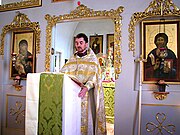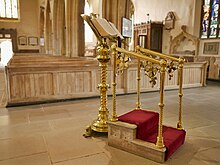Ambo

The Ambo (also Ambon, from ancient Greek ἄμβων Ambon raised edge. ', For example, a bowl, and later Kathedra or pulpit to ἀναβαίνειν anabainein , climb'; Latin equivalents are gradus and medium latin lectorinum , Lectorium and lectrinum ) is in orthodox , Catholic and Lutheran churches the elevated place from which the lecturer , deacon or priest delivers the biblical readings or the Gospel . The 'going up' is explained in a word of the prophet Isaiah: “Go up a high mountain, Zion, messenger of joy” (Isa. 40: 9). One climbs to the elevated ambo to announce the coming of the Savior to the people.
history
Aachen Cathedral : pulpit-shaped ambo of Henry II from 1002/1014
Basilica di San Vicinio in Sarsina : desk- shaped ambo, 12th century
The ambo comes from the old church , but was largely out of use in the Middle Ages. Instead, a lectern in the chancel has been used for reading the Bible and the pulpit in the nave for sermons .
Already in late antiquity, pulpit-like venues were created for speeches by clergymen standing (as opposed to the seated bishop on the cathedra ), such as the ambo of Sant'Apollinare Nuovo from the 6th century in Ravenna. The ambo of Heinrich II. (Sometimes also "Heinrichsambo" or "Heinrichskanzel") from the early 11th century in Aachen Cathedral has the shape of a pulpit without a sound cover .
But ambones were also repeatedly created, which - apart from the rich decoration - were only slightly raised standing desks, such as the one from the 12th century in the cathedral of Sarsina or the one from the 18th century in the pilgrimage church Mariahilf zu Freystadt .
From the 14th century there are ambones in the form of simplified pulpits, for example the two on the choir screen of the church of Santa Maria in Cosmedin in Rome.
Santa Maria in Cosmedin , in Rome : paired ambon, 14th century.
Priest, clad in Phelonion , at the ambo of the Russian Orthodox Church in Düsseldorf
present
Orthodox churches
In the Orthodox churches , the ambo can be in the form of a rounded stair landing in front of the royal door in the center of the iconostasis , or it can be a table in front of the center of the iconostasis. A desk that can usually be moved, often on the side, is also possible. The deacon prays to the litanies from the ambo . The ambo is the place where the gospel and homily are recited .
Catholic Church
In the course of the liturgical reform after the Second Vatican Council , the anvil was revived in Catholic church building .
The use of a separate place for the reading of the Holy Scriptures is intended to underline the great importance of the Word of God for the Christian community. This is where the gospel is preached. The response psalm and the Easter praise ( exultet ) are also recited on the ambo. While the ambo is the usual place for the sermon ( homily ) for the priests and deacons , the bishops have the choice between the cathedra and the ambo.
The ambo (“table of the word”) and altar (“table of the meal”) are the central places of worship in and in front of the apse . “Table of the Word”, however, is not a name for the anvil, but a figurative expression for the preaching of the Word of God in divine service.
The logophore is a special place for storing the Bible or the Gospel .
literature
- Leonie Reygers : Ambo . In: Otto Schmitt (Ed.): Reallexikon zur Deutschen Kunstgeschichte . Volume 1: A - Construction. Metzler, Stuttgart 1934, Col. 627-636 ( web link ).
- CMM Bayer u. a .: Treasure art in Rhenish churches and museums. 1st edition, Verlag Schnell & Steiner, Regensburg 2013, ISBN 978-3-7954-2827-3 .
Web links
- Basic Order of the Roman Missal (2002) , Chapter V, No. 309: The Ambo. (PDF; 532 kB)
- Gunther Seibold (engineer and Protestant theologian): www.kirchenbau.de, liturgical room
Individual evidence
- ^ W. Pape, Greek-German Concise Dictionary Volume 1, p. 119
- ↑ Novum glossarium mediae Latinitatis ab anno DCCC usque ad annum MCC. Vol. L. Copenhagen 1957, p. 47, p. v.
- ^ Sant'Apollinare Nuovo. In: web.romascuola.net. Retrieved December 28, 2015 (Italian).
- ↑ Thomas Hope, A. Baron, Gaetano Imperatore, Storia dell'architettura , 1840
- ^ Encyclopædia Britannica: Ambo
- ↑ Martin Klöckener, Bruno Bürki, Arnaud Join-Lambert (eds.): Présence et rôle de la Bible dans la liturgie . Saint-Paul, 2006, ISBN 9782827110032 , p. 356.






